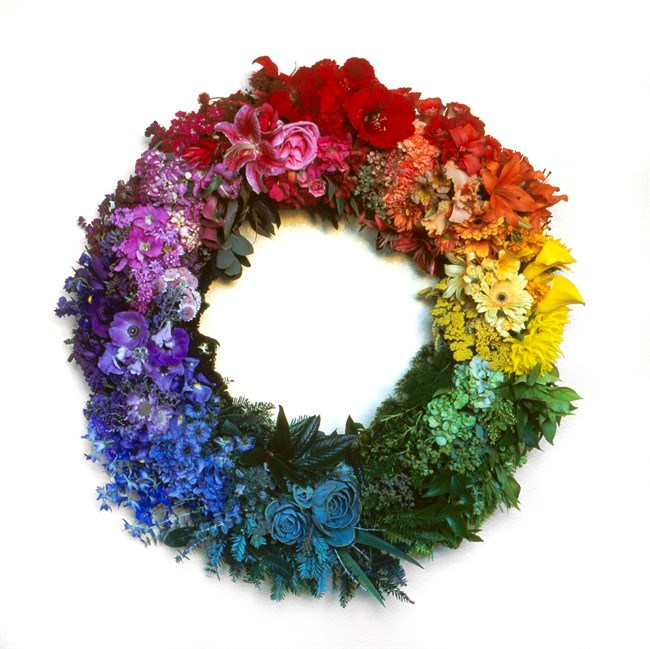Long a companion for artists, the colour wheel can also be a handy tool for gardeners.
Gardening author Sydney Eddison created a wheel that has 252 colours instead of the usual 12. That's because nature doesn't work with a limited palette, she says.
"In nature you have already been dealt this hand. You only have to learn how to play it," she says.
Even all of the tints, shades and tones in Eddison's "The Gardener's Color Wheel" don't capture the diversity of what's really growing out there. But she says it's a good way to start seeing colours in the garden and how they relate to each other.
"The colour wheel trains your eye to look, to really look," says Eddison, author of six books including "The Gardener's Palette" (Contemporary Books, 2003). "You begin to understand why certain things work, or why you like a Christmas wreath that's red and green and why you're happy to see purple and yellow crocuses together."
In both examples, the two colours are complementary — opposite each other on the colour wheel — and in colour theory, opposites attract.
In garden planning, colours are used to create either contrast or harmony, says Eddison, who has tended 2 1/2 acres in Newtown, Conn., for half a century.
"Contrast calls attention to itself. It gives a jolt," says Eddison, 81. "Whereas harmony is a sigh of relief."
Colours adjacent on the colour wheel, such as the warm shades of red and orange or the cool tones of blue and green, create harmony together.
Take a colour wheel into the yard to parse out particular colours. Take it to the garden centre to help pick out plants for the summer.
Then play in the soil.
Eddison recommends experimenting with colour in pots on the terrace.
"Don't force a colour theme on the garden," she warns. "It has different colours at different times of the year."
Colour also changes throughout the day, depending on the light.
Eddison changes her patio pots every year, and paints her garden furniture to co-ordinate.
"Sometimes my colour schemes are a little wild I had a Crayola colour scheme one year," she says. "People were blinded by it, but I loved it."
"The year that I did yellow, white and yellow-green, that was terrific," Eddison says. "And I painted the furniture yellow."
Look to fabrics or famous artwork (Monet's paintings, for example) for colour inspiration, she suggests.
Or simply trust nature, which turns out complementary colour combinations all its own, says Betina Fink, an oil painter who teaches colour theory in Tucson, Ariz.
"There are these beautiful, naturally occurring complementary colours," she says. During spring in the Southwest, for example, prickly pear cacti sport buds and blooms ranging from yellows to purples.
Jeni Webber, a Berkeley, Calif., landscape architect and Eddison's niece, also suggests taking nature's lead. Purple, yellow, white and soft pink constitute nature's palette in California fields, she says, and they look great together.
"Nature doesn't worry about things matching," says Webber. "But usually it does."
When planning a garden, remember that cool colours, such as blues and violets, recede, says Fink. Warm colours — reds, oranges and yellows — want to take centre stage. Green — nature's most abundant colour in many places — is "the great peacemaker," says Eddison.
"Green doesn't call attention to itself or vanish," Eddison says. "It helps harmonize all of the colour schemes."
An incompatible colour scheme can be softened by incorporating more soothing green foliage. In particular, grey and grey-green foliage helps blend colours.
Meanwhile, a little white goes a long way in the garden, warns Eddison.
"It is the lightest and brightest and most eye-catching colour in the garden," she says. "It requires special handling."
White works well with individual colours or combined with pastels. Low-growing white flowers, such as the tickseed plant "Star Cluster" Coreopsis, when spread throughout a garden can help the eye scan its surroundings.
Flowers come and go, but foliage often remains year-round, so plan it carefully, says Webber. She likes orange foliage, a relative newcomer, and mentions the perennial Heuchera Marmalade, a variety of coral bells.
Instead of hard and fast rules, Webber trusts her eyes to know when two plant colours clash: A bad combination hurts. "If I'm cheating and putting colours together that don't go well together, I'll see how my eyes are feeling," she says.
Over decades of experimenting with colour, Eddison also has found that rules can only get a gardener so far.
"As much as following the rules works, ditch them to follow your heart and soul," she says.
Eddison's colour wheel and instructional booklet may be purchased from the publisher, The Color Wheel Co. in Philomath, Ore., online for $15. The booklet's cover depicts a floral wreath created by Webber that emulates a colour wheel.
___
Online:
www.betinafink.com
www.thegardenerscolorwheel.com
www.jeniwebber.com
http://leeannewhite.com



